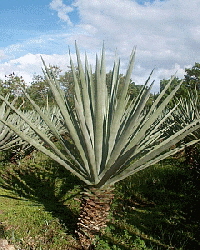|
 Sisal is a hard fibre extracted from the leaves of sisal plants which are perennial succulents that grow best in hot and dry areas. Sisal is an environmentally friendly fibre as it is biodegradable and almost no pesticides or fertilizers are used in its cultivation. World production is about 300,000 tonnes. Sisal is a hard fibre extracted from the leaves of sisal plants which are perennial succulents that grow best in hot and dry areas. Sisal is an environmentally friendly fibre as it is biodegradable and almost no pesticides or fertilizers are used in its cultivation. World production is about 300,000 tonnes.
a) Biology of sisal
b) Sisal fibre
c) Cultivation and harvest of sisal
d) Commercial sisal fibre extraction (opens new page)
e) Extract your own sisal fibre (opens new page)
f) Uses of sisal fibre (opens new page)
g) History of sisal fibre (opens new page)
h) Environmental benefits of sisal fibre (opens new page)
a) Biology of Sisal
Sisal is a member of the agave family, which are hardy plants of arid regions of Central America, Mexico and South West USA. In the past, several species of Agave were used for fibre production, but now A. sisalana is the commercially grown species. Henequen (A. fourcroydes) is another species of agave that produces fibre, but not of as high quality as A. sisalana.
Sisal plants consist of a rosette of fleshy leaves growing from a central bud. The leaves are dagger shaped and when mature 1 m to 1.5 m long and about 10 cm wide. Young plants may have minute spines along the edge of the leaf, but they soon loose them, with only the sharp tip remaining. The leaves are heavy, weighing 500 to 700 grams each, 90% of the weight being moisture. Despite the high water content, the fleshy pulp is firm and the leaves are rigid.
The plants grow for 7 to 12 years and then produce a flower stalk 4 to 6 metres tall and die. Although some flowers produce seeds, sisal plants are usually sterile and most propagation is by bulbils produced in the flower stalk, or by suckers that appear at the base of the plant.
b) Sisal Fibre
Sisal fibre is very long, with an average length of 0.6 to 1.2 m and it is creamy white to yellowish in colour. It is coarse and strong, durable and has the ability to stretch. It also has good insulation properties and it is highly resistant to bacterial damage and to deterioration in saltwater.
The fibre lies along the length of the leaf, being most abundant near the surface of the leaf where it is long and strong. The interior fibres are weaker, and they are usually removed during processing.
c) Cultivation and Harvest of Sisal
Sisal plants grow fast and all year round. The first harvest can be made when the plants are about two years old and they remain productive for 10 to 12 years. Each plant produces 180 to 240 leaves in a lifetime yielding 1 to 4 tonnes of fibre per hectare.
Sisal is a labour intensive crop and it offers employment to rural communities in areas which are often not suitable for other crops. The workers go round the plantation and cut some leaves from each plant every few weeks. They deposit the heavy leaves at the end of rows from where they are taken to a central processing unit. Almost no fertilisers are used in sisal production, they are resilient to disease and most of the weeding is done by hand.
Next page:
d) Commercial sisal fibre extraction (opens new page)
e) Extract your own sisal fibre (opens new page)
f) Uses of sisal fibre (opens new page)
g) History of sisal fibre (opens new page)
h) Environmental benefits of sisal fibre (opens new page)
Top of page
|

